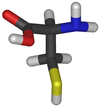Cysteine
Cysteine is a naturally occurring hydrophobic amino acid which has a thiol group and is found in most proteins, though only in small quantities. When it is exposed to air it oxidizes to form cystine, which is two cysteine molecules joined by a disulfide bond. N-acetyl-L-cysteine (NAC) is derived from cysteine and is a popular dietary supplement that is metabolized into the antioxidant glutathione. more...
Biochemistry
Cysteine contains a highly nucleophilic thiol group, and one of its primary purposes is to act as a nucleophilic catalyst. Since the pKa of the cysteine thiol approximately 8, its chemical activity is very easily tuned by its environment (compare to histidine which has a pKa of approximately 6.5 and is used similarly). Some important cysteine nucleophiles include ubiquitin ligases, which transfer ubiquitin to its pendant proteins, and caspases which engage in proteolysis in the apoptotic cycle. Inteins often function with the help of a catalytic cysteine. These roles are typically limited to the intracellular milieu, where the environment is reducing, and cysteine is not oxidized to cystine.
Cysteines play a valuable role by crosslinking proteins in an intramolecular sense. This increases the molecular stability in the harsh extracellular environment, and also functions to confer proteolytic resistance (since protein export is a costly process, minimizing its necessity is advantageous). Intracellularly, disulfide bridges between cysteines within a polypeptide support the protein's secondary structure. Insulin is a hallmark of cystine crosslinking, where two separate peptide chains are connected by a pair of disulfide bonds. The arrangement of disulfide bonds in hair arising from cysteine influences its degree of curliness.
Protein Disulfide Isomerases catalyze the formation of disulfide bonds; the cell transfers dehydroascorbic acid to the endoplasmic reticulum which oxidises the environment. In this environment, cysteines are generally oxidized to cystine and no longer functions as a nucleophile.
Dietary Sources
Cysteine can be found in red peppers, garlic, onions, broccoli, brussel sprouts, oats, and wheat germ. However, it is not an essential amino acid, and can be synthesized by the human body if a sufficient quantity of methionine is available.
Production
It is interesting to note that currently cheapest source of material from which food grade L-cysteine may be purified in high yield by hydrolysis from is human hair. Other sources include feathers and pig bristles. The companies producing cysteine by hydrolysis are located mainly in China. Some debate whether consuming L-cysteine derived from human hair is cannibalism. Although many other amino acids were accessible via fermentation for some years, L-Cysteine was unavailable until 2001 when a German company introduced a production route via fermentation (non-human, non-animal origin.)
Applications
Cysteine (mostly in the naturally occurring form L-cysteine) is used for applications in the food, pharmaceutical and personal care industries. One of the largest applications is the production of various flavors. For example, reacting cysteine with sugars in a Maillard reaction yields meat flavors. L-cysteine is also used as a processing aid for baking. Small quantities (in the tens of ppm range) help to soften the dough and thus reduce processing time.
Read more at Wikipedia.org



